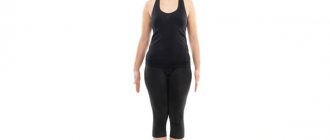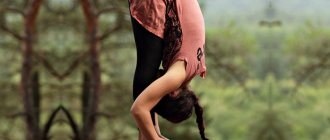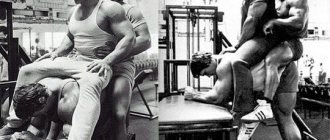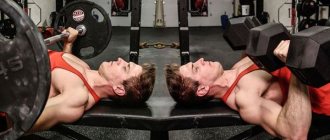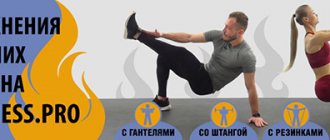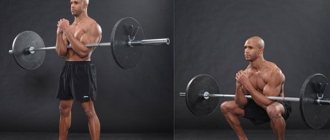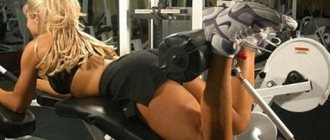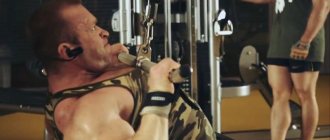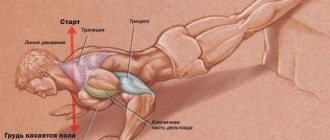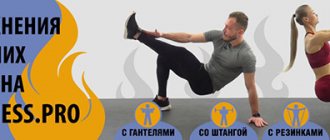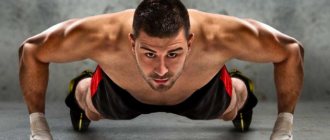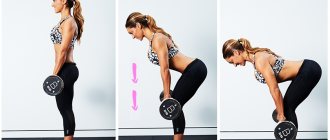The half squat exercise with a barbell is actually practically no different from the classic squat with a barbell, except for one thing - the depth of the squat itself.
That is, even from the very name of the exercise it is clear that in a half squat with a barbell, squats are performed only halfway, and not until the legs are fully squatted.
This exercise uses all the same muscles that are involved in a regular squat, but there is a difference. What is it?
Power-Fit is discussed below.
What is the difference between a half squat and a squat?
When performing a half-squat, you should not bend your legs completely, as if freezing halfway to full bending of your legs. This way the athlete gets an additional opportunity to work with significantly larger weights. In other words, this is exactly the point of the half-squat exercise.
The half squat is especially popular in powerlifting for faster development of strength in the leg muscles, in contrast to classic squats with a barbell. As a result, the result of hard training will be a noticeable increase in working weights.
A similar desire among athletes to increase working weights can often be found in powerlifting. After all, in the same bodybuilding, the task of athletes is completely different, as in fitness and in crossfit.
Half squat or full squat?
I think there is no particular point in writing about the benefits and uniqueness of this exercise; many articles and even full-fledged books have been written about its benefits both from the point of view of working out the muscles and the general health-improving effect. The impetus for writing this note was the following observations: many beginners in the gym, working out without a trainer, using a program downloaded from the Internet or written by another online guru, try to do a deep squat, although technically they are not yet ready for a regular half-squat. As a result, looking at what they are doing, it becomes simply scary for their future... And on the other hand, regarding the girls, many of them have flexibility and anthropometry that allow them to do a very high-quality squat below parallel, but for some reason they do it at best floor, and sometimes “third squat”...
So, let's look at the definitions. A squat or full squat is a squat when the top of the legs at the hip joints is lower than the top of the knees. When they are at the same level, this is called a parallel squat or half squat. When the knee is lower than the top of the hip joints, this is usually a technically incorrect execution, except in cases where such a technique is chosen consciously, with the aim of greater specialization on individual quadriceps bundles.
With the half-squat, I think everything is clear; learning to do this exercise correctly is one of the most important tasks of any person visiting the gym, of course, if there are no serious medical contraindications. With a full squat the situation is more complicated. We will not consider professional athletes from strength sports, for whom doing a partial squat is considered extremely immoral; we will talk about ordinary amateurs who want to improve their appearance and muscle functionality.
The first and most important thing that an amateur who is learning to squat needs to take into account is that not all people, due to anthropometric data, can do a deep squat. There is a certain percentage of people who will not be able to squat below parallel without putting a compressive load on the lumbar spine. And it doesn’t matter how seasoned the coach is teaching them. Such people need to strictly limit themselves to half-squats, or even replace them with a less effective exercise, but maintain a healthy spine. For a beginner, due to the small working weight, the injury will not make itself felt immediately, but it will accumulate, the so-called cumulative injury, which is even worse, because when it makes itself felt, the negative processes will be irreversible. Therefore, for a beginner, it would be optimal, under the guidance of a competent trainer, to choose a squat technique (after strengthening the muscles of the core - abs - lower back) that is optimal for his data, or to choose an alternative in the form of a hack squat, leg press or squat in a Smith machine, etc.
Let's consider another very important point, especially concerning the female half. Practice shows that girls master deep squats better than men, apparently this is due to better natural flexibility. So, let's say a girl or young man has learned to do a deep squat. Now the question of expediency must arise. The deep squat technique can also be different, and depending on this, the lion's share of the load will fall on either the quadriceps or the gluteal muscles along with the lower back. Therefore, a girl who wants to pump up her butt runs the risk of pumping up her powerful quadriceps even more, although her technique will be safe. To prevent this from happening, you need to compare two things: your goals, i.e. which muscle group needs to be emphasized to create ideal proportions and your squatting technique. If the goal is the gluteal muscles, and due to the technique, the quadriceps are more loaded, then it would be more advisable to use various variations of lunges and other exercises to pump up the buttocks.
Lunges are perhaps the best exercise for the buttocks. Stepping your foot to the side helps stretch the gluteal muscle as much as possible.
And if the goal is to increase the thigh volume of a slender girl, then this technique is quite suitable.
The same applies to men: if a young man naturally has quite large gluteal muscles, and he also does a deep squat in which a greater percentage of the load will be on the buttocks, then there is a risk of developing undesirable proportions for men... Therefore, be careful and attentive and pump exactly what you need!
Half-squats are a 100% way to get out of stagnation.
Actually, this is the hidden meaning of this exercise. If your training consists of constantly lifting heavy weights, as well as building muscle mass, then every athlete sooner or later faces the same problem - muscle stagnation. This is when the muscles are already accustomed to the weight being lifted and do not tend to start growing again.
Thus, the half squat will help bring something new to your training program, successfully loading your muscles with a completely different type of load, giving them a reason to continue to grow further. A half squat with increased weight immediately gives the command to the muscles to grow, since having received a certain portion of stress, the body understands that it may not be able to cope with the load, and it is necessary to quickly begin building muscle mass in the legs, back and core.
Thus, previously poorly used muscle fibers of the leg muscles will begin to give 100%. In other words, the half squat is a 100% working way to get out of stagnation.
Execution technique
Legs are a large muscle group in the human body, which is why they need to be trained so that all areas of the muscles work. We do the exercise carefully, as the knee joints are subject to stress. The difference from squats is that the knees are under constant tension.
We take into account that the lower back and knees are strained. Use a safety belt that covers your waist. For your knees, use an elastic bandage that is not too tight; it will retain heat and provide additional protection to the joints. Before class you need to warm up.
Let's look at the correct technique - a half squat with a barbell:
- Climb under the barbell, pointing it towards the middle of the trapezius, place your feet wider than your shoulders, and hold the barbell with a closed grip.
- Bend your back at the lumbar region until lordosis forms (curve of the spine, convexity forward). Turn your toes and knees to one side.
- Remove the barbell by taking two steps back.
- Slowly, under the guidance of another person or trainer, squat down so that your knee forms a 120-degree angle.
- If you exert force on your legs, return to the starting position, do not straighten your knees completely, keep your muscles under load.
Do 4-6 repetitions. There is a half squat - sumo, plie. They are suitable for girls. Do the exercises first without weights, and then add dumbbells.
A plie is a lightweight form of a half-squat with a barbell, focusing on the buttocks and inner thighs. The main rule of how to do it is a straight back with legs set wide apart. Pointed socks contribute to the greatest load and make work easier. Involved - soleus muscles, abdominal and buttock muscles.
Benefits: safety, improves body coordination, blood circulation in the pelvic organs, training the muscles of the lower body. Perform up to four approaches, about 15 times. Add dumbbells to your workout.
Sumo - designed for the gluteal muscles. From the outside, the movement looks like a person sitting down on a chair. When performing the exercise, it is necessary to move the pelvis slightly back, tilt the back 30 degrees, toes turned out, legs wider than shoulders. The lumbar, gluteal muscles, and inner thighs are pumped.
Girls should not get ahead of the curve, starting with half squats with a barbell. The body is not prepared for the load. Everything can end in injuries, broken knees, damaged vertebrae.
Variations
- Simplified version
Beginners often have two problems with this pose:
A . they cannot keep the heel locked on the floor when they begin to bend the front knee;
B. _ cannot touch the floor with their palm when entering the asana.
To solve the first problem, perform the asana against a wall, fixing your heel. As you bend your front knee and lower your torso to the side, imagine using your heel to push the wall away from you.
To solve the second problem, either leave your forearm on the top of your flexed hip (instead of touching your hand to the floor) or use a brick/block behind your front leg as a hand support.
- Complicated version
You can also perform this pose by placing your hand in front of your flexed hip. This will help create more stretch in the front of the groin.
As you lower your torso to the side, lower your arm in front of your foot so that the back of your shoulder touches the inside of the knee of your bent leg. Push your shoulder into the knee, and resist with your knee - straining the inner part of the bent leg. Lengthen the side along the inner upper thigh.
What muscles work
Exercises involve the muscles of the lower extremities. It takes training to get all the segments to work.
When carrying out the task, muscle groups work: quadriceps (forming most of the front of the thigh and side part), gluteal muscles, soleus (located under the calf - look flat), gastrocnemius (visible part of the mass of the lower leg at the back) muscles, back extensors, abdominal muscles.
Soleus, gastrocnemius - are responsible for blood circulation, they ensure the proper functioning of the muscle-venous pump so that the heart maintains normal blood pressure.
Pay attention to the knee joints and spine, which are subject to stress. Possibility of injury. Before starting work, you should warm up. When doing a half-squat, the nervous system of the joint - the ligamentous apparatus - is trained more.
Is a half squat necessary for a bodybuilder?
The question involuntarily arises: if the half-squat is used by security forces, is it needed, say, by a bodybuilder?
After all, muscle strength is of secondary importance for him; the primary goal is their volume. The answer is: for gaining leg mass, a partial squat is less effective than a deep squat, due to the fact that the muscles stretch less. It makes sense to perform it if the athlete, due to his physiological characteristics, cannot correctly squat to full amplitude. Also, an atypical load can give impetus to overcoming stagnation in muscle development. In other words, there is no urgent need to do half squats for people training for weight, but it always makes sense to try.
Adjustment of asanas / control points
- twist your pelvis inward and pull in your right buttock so that your pelvis does not protrude back, but is in line with your hip and knee;
- the upper part of the thigh should be strictly parallel to the floor, and the section of the leg from the knee to the ankle should be perpendicular to the floor;
- contract your shoulder blades and turn your chest to the left and back so that your chest is expanded and the back of your body remains in the same plane;
- draw in your left armpit, biceps, wrists and elbow. The body from the left ankle to the left hand is taut like a string - this can maintain balance in the pose.
- It is important to set the correct distance between the legs , otherwise the bent leg will not have a right angle. The distance is selected individually according to the person’s height. When adjusting the distance between your feet, move only the “back” leg, not the bent one!
What can be replaced
For beginner athletes and people who have been injured, we use a different technique, since their muscles are not yet very developed, and a lighter technique is required.
Deadlift
More muscles are involved during work. You need to stand closer to the bar, legs narrower than shoulder width, feet parallel, bend your knees and grab the bar with an overhand grip.
Straighten and tense your back. Lower the barbell calmly and do not throw it. Throwing leads to stretch marks and damage to the vertebrae.
Leg press and hack - squats
They are performed on simulators with a platform moving at an angle. Use more weight. An imitation of a half-squat is created. The back is pressed, the legs are located at the required angle, we hold on to the handles of the simulator, smoothly lower the platform down, then lift it up.
Hack - squats - the barbell is held with straight arms behind the back. Use shoes with ridged soles to prevent slipping on the platform. The lumbar region, as in a leg press, is pressed tightly.
Squats with a weight on a belt
Here we use a belt on which dumbbells or other weights are hung. We squat as if into a “pit”, which is made of pancakes and our feet are placed on them. Do a deep squat.
Squats with outstretched arms and dumbbells in hands
Bend your knees, squat until your hips are horizontal, placing emphasis on the middle of your foot. The back is straight, there is no bending either back or forward. Hands forward, squat. Requires attention, incorrect execution leads to joint injury. Suitable for practicing at home.
With dumbbells - suitable for people with back problems, the same for men and girls. The main thing is to maintain the position of your back and balance. The technique is the same, just add dumbbells.
https://youtu.be/zm1gzL8uBQg
Sport and health
Squats with a barbell on your shoulders are the main exercise for developing the muscles of the legs, in particular the quadriceps. Squats also have a stimulating effect on the overall development of all muscle groups, because this basic movement affects the powerful production of hormones, which results in increased strength and a more athletic appearance. Another important benefit of squats is training endurance and strengthening the cardiovascular and musculoskeletal systems. All these features of this exercise make it one of the main ones in athleticism, however, when performing it, the question often arises: what is the best way to squat, until the thigh is parallel to the floor or in a full-amplitude style (deep squat)?
If you look at it in general, squats with a full amplitude are considered more effective, since here the quadriceps work harder, because you have to rise from a lower position, which makes the whole process much more difficult. You could even say that one repetition of a full-range squat includes two repetitions of the variation to parallel. In addition, deep squats do not require heavy training weights,
to work the quadriceps, since even with a moderate load the leg muscles become extremely tired, which means the impressive weight of the barbell will not put pressure on the spine. However, with all the advantages, there are pitfalls. The full range of squats can overstress the knee joints, which over time can lead to knee injury. This dangerous effect does not occur in everyone; it all depends on the anatomical structure. As a rule, people with tall or average height with a thin physique (ectomorphs) are more suitable for squats to parallel, because in full-amplitude they begin to fall forward, which is why the main part of the load is shifted to the knees, and this is the most dangerous thing for the joints. Plus, getting up from a deep squat is much more difficult and longer for them. In turn, short, muscular athletes (mesomorphs/endomorphs) are more predisposed to full-range squats. Under load, they better keep their back straight and do not fall forward, and thanks to their short stature and powerful strength potential, they rise faster from a squat. All of these benefits make deep squats much safer.
The most important thing in leg training is to intuitively determine for yourself the correct trajectory of movement that does not cause discomfort or pain in the joints. It is necessary to listen sensitively to the signals of your body and act accordingly to them. For squats, this means paying close attention to how your knees feel. If, during full-amplitude sets, slight pain discomfort appears in the knee joints or their clicking, you should immediately switch to the version up to parallel. With this option, the knees are not overstrained, but the quadriceps still receive the load, albeit somewhat less. To increase the intensity of your training, it is not necessary to place an impressive weight on the barbell. The quadriceps can be worked hard by performing repetitions faster, or increasing their number, for example, to fifteen, as well as reducing the rest time between sets.
The only squat variation where full range of motion is most effective and safe is the bodyweight squat. The goal of the exercise is not to gain muscle mass or extreme strength, but to generally strengthen the muscles of the legs, musculoskeletal and cardiovascular systems. There is no additional weight, which means it is better to perform deep squats, as this will only improve your performance.
There is also a third version of squats - partial (above the parallel of the thigh with the floor). This style is best used periodically at the end of a standard approach, when the final particularly heavy repetitions are performed, in order to further work the quadriceps.
In all types of squats, the breathing technique remains the same: squat - inhale, rise - exhale.
Leg muscle training program:
1) Squats with a barbell on the shoulders (full amplitude or to parallel): 4 sets, 10-15 reps
2) Leg extensions in the simulator: 3 sets, 10-12 reps
3) Leg curls in a lying machine: 3 sets, 10-12 reps
4) Deadlift on straight legs (for enhanced development of the hamstrings): 3 sets, 10-12 repetitions.
In contact with
LiveJournal
